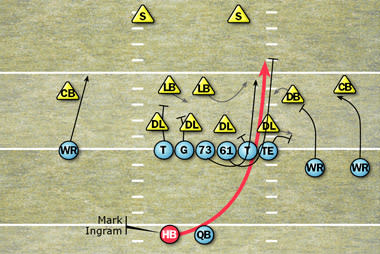Ingram expected to provide power, consistency
When the New Orleans Saints won Super Bowl XLIV at the end of the 2009 season, they did it with the most diverse passing attack in the NFL. Head coach Sean Payton ran a multifaceted set of schemes that drove defenses crazy. And as much as that effectiveness had to do with the talent of the receiver corps and quarterback Drew Brees(notes), the hidden factor in that offense was the presence of running back Reggie Bush(notes). Whether Bush accumulated great stats or not was irrelevant in a general sense, because the mere threat of him making – and breaking – a play on the field forced defenses to alter their coverage concepts.

Mark Ingram(notes) could help the Saints can return to their Super Bowl form.
(Getty Images)
When Bush lined up in the slot, the Saints saw more nickel defenses than just about any other team. And when Bush motioned from the backfield to the slot, linebackers were caught in matchup nightmares. Other receivers, who never should have seen single coverage, were getting it on a regular basis because Bush moved coverage to places that defenses didn't want it to go.
But when Bush missed several games last season with a fractured fibula, the Saints were left without an equivalent threat of Bush's caliber. Add in the 10 regular-season games missed by fellow running back Pierre Thomas(notes), and you had a defending Super Bowl champion led in rushing yards by undrafted rookie Christopher Ivory(notes). Payton's offense had worked with that kind of rotation before, but there were too many moving parts required, and too many perfect scenarios needed for it all to go.
And in an NFL that has ceded more power to the idea of running back rotations in recent years, that's why the Saints went against type and selected Alabama running back Mark Ingram with the NFL draft's 28th overall pick that they'd acquired from the New England Patriots. A rare legitimate three-down back, the '09 Heisman Trophy winner is a hyper-valuable do-it-all player in the old-school mold when NFL teams ran their backs into the ground with nary a thought to career length. Ingram is a great inside rusher who also can blast outside under the right circumstances, but he can catch and block as well. That should put him on the field quite a bit in a slightly refurbished New Orleans offense.

Ingram will be a great fit for the Saints, especially if Bush manages to stick around with a renegotiated contract, because the thought of a power back of Ingram's caliber running against a pass-sensitive nickel defense must have Payton smiling a lot in anticipation – especially given the quality of New Orleans' starting interior linemen, featuring guards Carl Nicks(notes) and Jahri Evans(notes). Until the lockout ends, Payton will have to enjoy watching plays like the one Ingram pulled off against Auburn in the 2010 Iron Bowl.
On the Crimson Tide's fourth play from scrimmage, a second-and-3 from the Auburn 49-yard line, the plan was to go power from shotgun and have Ingram run behind the pull-blocks of center William Vlachos (73) and right guard Anthony Steen (61). Ingram hit that lane against Auburn's nickel defense (set against Alabama's shotgun, three-wide formation) and cruised up the gap for five yards and a first down. At the end of the drive, Ingram hit the cutback lane hard left for a nine-yard touchdown.
With or without Bush in the future, the Saints are set to run the kind of power offense that travels nicely and works well in all weather. It's just what a team looking to get back to the Super Bowl needs.
